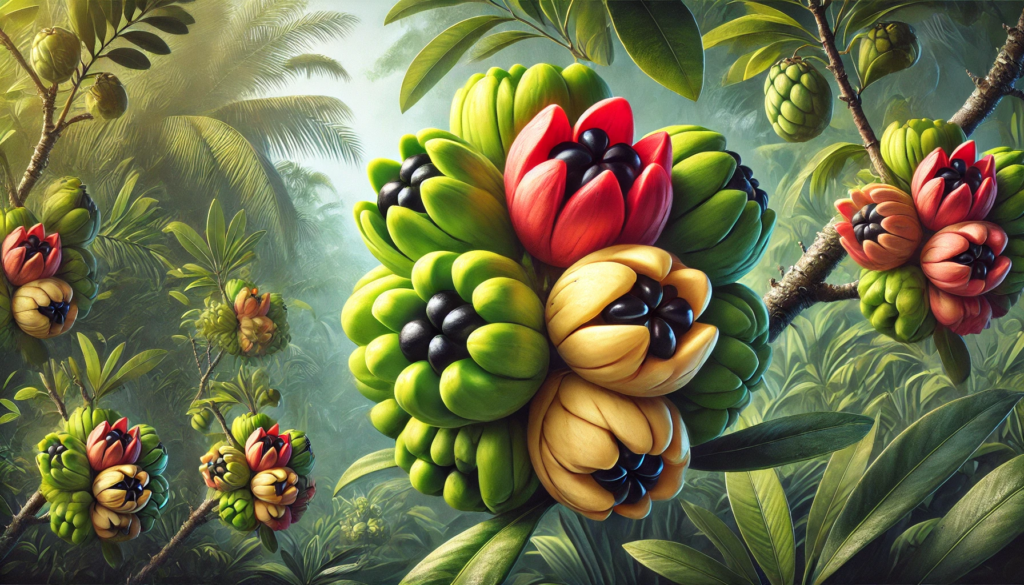The Ackee (Blighia sapida) is a tropical fruit that holds significant culinary and cultural importance in the Caribbean, particularly in Jamaica, where it is the national fruit. While it is beloved for its creamy, buttery taste and often paired with salted codfish in the iconic dish “Ackee and Saltfish,” it also comes with strict safety considerations. The Ackee fruit must be properly harvested and prepared to avoid its toxic effects when unripe.
This article provides an overview of the Ackee fruit, its culinary significance, and the essential precautions that must be taken when handling and consuming it.
What is the Ackee Fruit?
The Ackee tree, native to West Africa, was introduced to the Caribbean in the 18th century. It thrives in tropical climates and is particularly abundant in Jamaica, where it is grown in gardens and orchards. The tree produces leathery, pear-shaped fruits that transition from green to bright red as they ripen. Upon ripening, the fruit naturally splits open, revealing three large black seeds surrounded by creamy yellow arils, which are the edible portion.
Physical Characteristics of the Ackee
- Fruit: The Ackee fruit is pear-shaped, measuring about 4 inches long. When ripe, it turns from green to red or yellow-orange and splits open to expose its edible arils and inedible black seeds.
- Arils: The fleshy yellow or cream-colored arils are the only edible part of the fruit. They have a smooth texture and a rich, buttery taste when cooked.
- Seeds: The black seeds are toxic and should never be eaten. They are glossy and smooth, adding to the fruit’s distinct visual appeal but signaling a potential hazard.
The Ackee tree typically grows to around 10–12 meters tall, with dense, evergreen leaves. The tree flowers year-round, but its fruiting season peaks between September and March, when Ackees are harvested for culinary use.
Culinary Importance of Ackee
Ackee is integral to Caribbean cuisine, particularly in Jamaica, where it forms the basis of the national dish, Ackee and Saltfish. Its rich, creamy texture, similar to scrambled eggs, makes it a versatile ingredient in a variety of savory dishes. Traditionally, it is sautéed with onions, peppers, and salted cod (saltfish), seasoned with herbs and spices, and served with dumplings, fried plantains, or roasted breadfruit.
Ackee and Saltfish: Jamaica’s National Dish
Ackee and Saltfish is one of the most famous Caribbean dishes, loved for its balance of rich, savory flavors. The preparation involves boiling the Ackee arils until they are tender, then lightly sautéing them with flaked saltfish, bell peppers, tomatoes, onions, and Scotch bonnet peppers. This dish is a staple of Jamaican breakfasts and is often served with side dishes like bammy, callaloo, or boiled green bananas.
Other Culinary Uses
Aside from its use in the national dish, Ackee can be used in a variety of other Caribbean-inspired recipes, such as:
- Ackee patties or turnovers
- Ackee and vegetable stir-fries
- Ackee soups or stews
- Ackee salads, often combined with avocado or seafood
Ackee’s mild, creamy taste allows it to be a versatile ingredient, complementing a wide range of flavors from spicy to savory.
Safety Considerations: The Toxicity of Unripe Ackee
While Ackee is a beloved and delicious fruit, it comes with significant safety concerns. The unripe fruit contains high levels of hypoglycin A and hypoglycin B, toxic compounds that can lead to a condition known as “Jamaican Vomiting Sickness.” These toxins can disrupt the body’s ability to produce glucose, leading to severe hypoglycemia (low blood sugar), which can cause vomiting, dehydration, seizures, and, in extreme cases, death.
How to Safely Consume Ackee
- Wait for the fruit to open naturally: The most critical rule when handling Ackee is to wait until the fruit has naturally ripened and split open on the tree. This indicates that the levels of toxic hypoglycins have dropped to safe levels.
- Discard the seeds and rind: Only the yellow arils are safe to eat. The black seeds and the red inner rind should be discarded, as they contain the highest concentrations of toxins.
- Boil the arils before consumption: Boiling the Ackee arils is essential for further reducing any residual toxins. The arils should be cooked until tender before being incorporated into dishes.
- Avoid consuming out-of-season or improperly stored Ackee: Ensuring that Ackee is properly harvested, handled, and stored is critical to safety. It’s best to consume Ackee when in season and avoid consuming it if the fruit has not opened naturally.
Conclusion
The Ackee fruit is a beloved staple in Caribbean cuisine, especially in Jamaica, where it forms the cornerstone of the iconic dish Ackee and Saltfish. Its rich, creamy texture makes it a versatile ingredient in various savory dishes. However, the fruit must be handled and prepared with great care due to its potential toxicity when unripe. By following proper safety measures—ensuring the fruit is fully ripe and cooking it thoroughly—the Ackee can be enjoyed safely and deliciously. Its role in Caribbean culture and cuisine remains profound, symbolizing the rich culinary traditions of the region.
FAQ
Is Ackee safe to eat?
Yes, Ackee is safe to eat when fully ripe and properly prepared. The fruit should be allowed to open naturally on the tree, and only the yellow arils should be consumed after cooking. The black seeds and inner rind are toxic and should be discarded.
What happens if you eat unripe Ackee?
Eating unripe Ackee can lead to “Jamaican Vomiting Sickness,” caused by the toxins hypoglycin A and B. Symptoms include vomiting, severe hypoglycemia, seizures, and, in extreme cases, death. Therefore, it is essential to only eat Ackee that has ripened and opened naturally.
How do you cook Ackee?
To cook Ackee, first remove the seeds and inner rind from the naturally opened fruit. The yellow arils should be boiled in water until tender, then drained. The cooked Ackee can then be used in dishes such as Ackee and Saltfish, salads, or stews.
Can you eat the black seeds of Ackee?
No, the black seeds of Ackee are toxic and should never be consumed. Only the yellow arils are edible after proper preparation.
What does Ackee taste like?
Ackee has a rich, creamy texture and a mild, slightly nutty flavor. When cooked, it has a consistency similar to scrambled eggs, which is why it pairs well with savory ingredients like saltfish, onions, and peppers.
When is Ackee in season?
Ackee is typically in season between September and March. During this time, the fruits ripen and naturally open, making them safe to harvest and eat.

